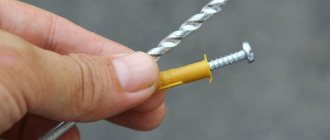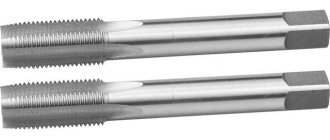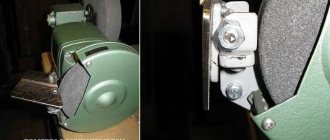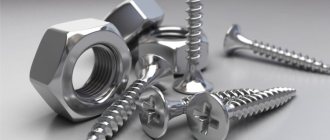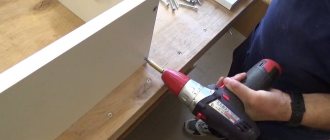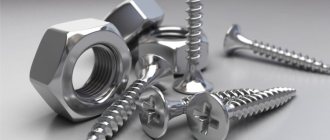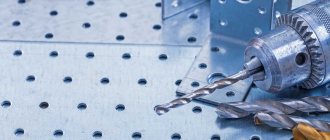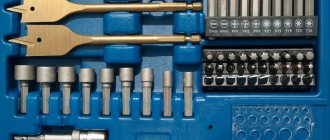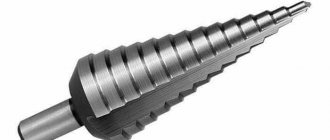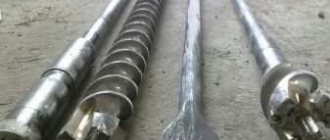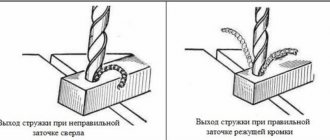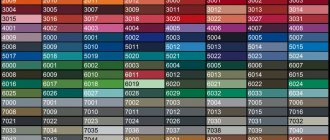The strength and durability of the entire structure depends on the choice of hardware, or fasteners, as any builder will tell you. One of the types of such fasteners are self-tapping screws. Their feature is that there is no need to cut threads to connect elements. In cases with self-tapping screws for metal, there is a tip option with a drill for thick-walled metal, profile pipe, angle, etc., or a sharp tip for thin or sheet metal, such as roofing.
Types of screws for metal
A self-tapping screw for metal can have an edge either in the form of a threaded tip or in the form of a drill. In addition, they are divided into several types:
- roofing screws,
- for fastening metal sheets up to 0.9 mm thick,
- for fastening metal sheets up to 2.0 mm thick,
- for drywall,
- for fastening gypsum fiber boards.
Each of these types has its own characteristics: thickness, length, thread width, head profile, tip type, metal grade. All characteristics are selected based on the area of application of this hardware and the force it must withstand.
Confirmat - furniture screw
Unlike a traditional sharp self-tapping screw, in this type of svfs the main feature is the blunt end. Furniture hardware has a countersunk head with a cross-shaped slot, as well as a rare threaded notch. Used for assembling furniture, fixing sheets of chipboard, MDF, plywood and other wooden planes, regardless of the weight of the element.
Roofing screws
Roofing tools are always characterized by a more complex design. Roofing screws are no exception. This is a combination of a screw and a traditional self-tapping screw: a round head with a slot for a screwdriver or a hexagonal recessed head and a sharp tip.
Length – up to 150 mm, diameter – up to 6.3 mm. Made from high carbon stainless steel. Used for fastening all types of roofing materials, regardless of weight and purpose.
Types of wood screws
These fasteners are divided according to several criteria. Depending on the material from which they are made:
- brass;
- stainless steel;
- carbon steel.
To ensure that the fasteners are resistant to corrosion, they are additionally treated with special compounds. There are several types of surface treatment for wood screw fasteners:
- Phosphated
- a carbon steel alloy treated with phosphates. Suitable for rooms with high levels of moisture. - Oxidized
– carbon steel with protection in the form of an oxide film. Can be used in ordinary rooms. - Galvanized
- the same base with a zinc coating. Can be used indoors or outdoors. - Galvanized yellow decorative wood screws
. Used to secure decorative gold-colored loops. - Without cover
. Screwed indoors.
According to their shape, wood screws are divided into:
- with press washer;
- with hex head;
- roofing screws;
- confirmations.
According to the type of carving, wood screws are divided into the following types:
- wide step;
- small step;
- double thread.
Hole for capercaillie.
Tell me which hole should be pre-drilled in the tree (pine) for capercaillie d6 and d8. I came across a sign somewhere, but I can’t find it. Or I dreamed it. —
Measure the diameter of the screw between the threads. I took a drill about 0.5 mm smaller than this diameter, for dry pine across the grain.
Metal sword plate. I would drill 4.5
Mikhalych wrote: under the wood grouse d6 and d8.
Vlad55 wrote: I would drill 4.5
Is 4.5 for both capercaillie?
So by eye. Some don't drill at all. I am not a supporter of this approach. Obviously, even a 3 mm hole for a capercaillie f8 will be a benefit. But probably the maximum. as they write - the diameter of the capercaillie between the turns. Well, somewhere around 5 mm for f8 and 4 mm for f6
2n-pn Yes. If you screw it to a log, you don’t have to drill it. If the timber is not of a large cross-section, then cracks may occur. It is advisable to lubricate the screw/capercaillie with something before screwing it in.
The fence must be screwed onto the roof, i.e. through the metal, to the sheathing - 25mm board. Capercaillie-d8. I'm afraid that without drilling, the board will crack. Yes, and it will be a little hard to twist through metal, without a hole, hanging on one hand. —
If you measure the diameter between the turns, it seems a bit too much. I twisted the balusters once - so, I didn’t like something at all - as soon as you want to tighten it, it turns. Therefore, the hole must be calculated somehow differently. Could it really be 3.5-4mm?
Mikhalych wrote: 3.5-4
Mikhalych wrote: Yes, and it will be a little hard to twist through metal, without a hole
Vlad55 wrote: then how?
Well, wood grouse don’t seem to have a drill at the end, unlike roofing screws. Or do you propose to score? —
p.s. Got it! My roof is metal tiles. Angle brackets 4mm thick. I made holes in them, size 8, and glued a rubber gasket (from a car inner tube; I couldn’t find another one. —
). I apply it to the roof, in the center of the hole in the corner, drill D4, then I wrap the capercaillie D8x50 and it presses the corner through the gasket to the roof. It seems like that's what I wanted. What's wrong? The roofing metal may “spread out” and will not allow the gasket to be pressed. —
I'm reporting. Conducted an experiment. Drilled d3.5. The screw won't fit on d8, you bastard! It rests on the metal and doesn’t want to screw it with the Boshik GDR. I drilled to d4, but with difficulty it went in to d8, the gasket pressed. I filled it with water and it didn't seem to flow. I left it overnight to continue the experiment. Apparently I'm on the right track. —
What hole in oak do you recommend?
I’ll revive the topic, because soon it will be necessary, after the “Golden Hands” workers, to redo something in terms of fastening the timber in the attic. My opinion is that, let’s say, if the “grouse” is 8, then drill a hole in the tree (possible/better?) at 6. What do you say, Colleagues?
I have wood grouse on 8 and 10 - working fasteners (well, offhand I screwed them on for sure more than twenty thousand
) Wood is a conditional concept, the drilling diameter is different, the approximate diameter is different, I usually use wood grouse 40 long (for steps), if you use long ones, then the hole diameter may even be slightly larger than in the table below (in any case, first a few holes to check , since wood from different sources can differ quite significantly in its characteristics) Under 8k in spruce 4.0-4.5 in pine 4.5-5.0 in larch 5.0-5.5 in beech 5.5- 6.0 In oak/ash - 6.0 (there may be particularly hard areas - up to 6.5) Under 10 - approximately plus 1.5-2 mm in relation to 8 for oak/ash - 8, 0
How to determine?
It is quite difficult to learn by heart all the standard sizes of self-tapping screws, and besides, there is no need for this. Furniture or other interior items are often sold with suitable fasteners, and to find out which screw to buy for a particular building material, just look at its thread.
Based on the type of thread, the following options are distinguished.
| Thread pitch | Purpose |
| Average | Universal. Suitable for metal, wood, asbestos, plastic, plaster and other materials. |
| Frequent (or even double entry) | Perfect for fastening metal profiles no thicker than 9 mm. They hold well without dowels, but require pre-drilling. |
| Rare | For highly soft materials: asbestos, gypsum, soft wood, plastic. Do not require dowels. |
| "Herringbone" | For brick and reinforced concrete. They require a dowel. |
| Notched | For brick and reinforced concrete. Do not require dowels. |
| Asymmetrical | For assembling furniture from chipboard, plywood, wood. Requires pre-drilling. |
In general, to select the correct size of self-tapping screw, you need to follow a few simple rules.
The length of the hardware must be such as to stitch the attached element right through and secure it to the base. Particular attention should be paid to the length of the screw when choosing fasteners for wooden structures. The fastening must pass through the parts and enter the workpiece no more than 1/3 of its thickness in cases where it is not secured with corners, and 1/4 if it is secured. The price of a self-tapping screw directly depends on its length, so using longer fasteners than necessary is irrational from the point of view of economy. The heavier the screw, the heavier the overall weight of the structure
This can be ignored during a single use, but in certain cases a builder can use up to several hundred thousand self-tapping screws on a structure, and in this case their total weight will be significant.
In order to select a dowel for a self-tapping screw, you can contact the store salesperson or use the following sign.
| Dowel | Self-tapping screw |
| 5 | 2,5-3 |
| 6 | 3,5-4 |
| 8 | 4,5-5 |
| 10 | 6 |
| 12 | 8 |
| 14 | 10 |
Main dimensions of Phillips, Poz self-tapping screws >
Each of the main types of splines also differs in size. In this case, for each type of spline a standardized and numbered row is formed:
- Phillips slots: Ph0, Ph1, Ph2, Ph3, Ph4;
- Pozidrive splines: Pz0, Pz1, Pz2 Pz3, Pz4;
- TORX slots: T (or TX) 2, 3, 4, 5, 6, 7, 8, 9, 10, 15, 20, 25, 27, 30, 40, 45, 50, 55, 60, 70, 80, 90, 100.
The differently positioned edges of the Pz slot form a more stable grip with the tool, which reduces its wear and reduces the likelihood of “breaking”. This makes it possible to apply more torque to the tool.
Russian version of the TORX slot according to GOST R ISO 10664-2007 (dimensions in mm)
For each type of slot and its size (number), a strictly appropriate tool is required: a screwdriver or a bit. Otherwise, rapid wear or even destruction of the drive elements is possible.
Differences between self-tapping screws and self-tapping screws
GOST 27017-86 defines a screw as a fastener in the form of a rod with an external special thread, a threaded conical end and a head at the other end, forming a thread in the hole of the wooden or plastic product being connected. From this definition it becomes clear that a screw is screwed into a previously prepared hole and is used for fastening to wooden or plastic bases. Such screws, usually made from low-carbon steels (St1, St2, St3, 10kp), less often from corrosion-resistant steels without coating and from brass, have traditionally been produced and are still produced by the domestic hardware industry.
However, fasteners have long appeared on the Russian market that, by formal definition, correspond to the term “screw”, but have significant differences:
- their main structural elements have been fundamentally improved: heads, threads on the rod, ends and splines;
- High-quality steels and alloys with modern protective and decorative coatings were used.
As a result, the functionality of these products has significantly expanded:
- it has become possible to install them without pre-drilling holes, which significantly simplifies and speeds up the installation process of the fastened products;
- The range of materials in which these products can be installed has expanded: steel, aluminum and copper alloys, composite materials, concrete, and brick have been added to wood and plastic.
Such significant differences between new products and screws required the emergence of a special term. And such products began to be called self-tapping screws, in short - self-tapping screws.
The main structural elements of screws or self-tapping screws are:
- head - part of a fastener that has a rod, serving to transmit torque and form a supporting surface;
- slot - a specially shaped recess at the end of the head, which serves to transmit torque from the tool;
- threaded rod;
- end.
Selecting the length of screws
There are several rules for choosing the length of a self-tapping screw that apply in different situations. When uniting/connecting two not very massive parts, the following selection rules apply:
- Whatever you connect, the sharp end of the screw should not stick out from the other side of the parts being connected. That is, in any case, it should be shorter than the parts being connected. Moreover, it is believed that maximum strength will be if at least 5-6 mm remains to the edge of the lower part. So consider it.
The length of the screw is selected depending on the parts being fastened
If some thin part is attached to a massive base, a different rule applies. Then the length of the fastener should be 2-2.5 times longer than the attached part. This is how you need to select the length of the screw if you are attaching something to a wall, say, or to a concrete floor. In this case, to fasten the same 28 mm board to the wall, the length of the fastener is 56-70 mm. That's the difference.
Self-tapping screw sizes: most applicable options
How to choose the length of the screws should be clear. Now about what they generally are. The situation here is confusing. Neither screws nor self-tapping screws have a common standard. There are several standards of “worn out” years of manufacture, which specify the dimensions of certain types of self-tapping screws.
- GOST 1145-80. Countersunk self-tapping screws.
- GOST 1144-80. Round head screws.
- GOST 1146-80. Screws with a semi-countersunk head.
The situation today is that each manufacturer produces its own “lines”. They focus, of course, on demand. Well, the parameters of the heads are usually made in accordance with one or another GOST. This will at least somehow stabilize the situation. Sometimes the assortment - diameters and lengths are also made according to the standard. In this case, in the description of the screws, the diameters in which they are generally produced are indicated, and then there is a postscript: it corresponds to such and such GOST. This means that the heads comply with the specified standard, and also that the assortment corresponds.
Main types of self-tapping screws
Depending on what materials need to be connected, choose a self-tapping screw with one or another type of thread. In this case, the following traditional quantitative characteristics for threads are taken into account:
But besides them, the angle at the top of the thread profile α has a significant influence on the self-tapping properties of the product. The smaller the specified angle, the easier the product is twisted, the easier the thread is formed in the hole, and the higher the self-tapping properties.
Traditional screws produced by the domestic industry (GOST 1144-80, GOST 1145-80) have this angle equal to 60º, like a metric thread.
Modern self-tapping screws are made with an angle α=45º and less. Such sharp threads are especially effective when installing products in relatively soft materials: wood, chipboard, plastic, etc.
Self-tapping screws intended for screwing into metal (DIN 7976, 7981...7983) are made with large angles (mainly 60º) to increase the strength of the thread at the base of the profile. In addition, the cutting edge of the product is subjected to special hardening heat treatment, which ensures a hardness of 450HV. Metal self-tapping screws are highly standardized products and their threads are manufactured according to ISO 1478, EN 2478, DIN 7970 standards. In the drawing and design documentation, the letters ST (SCREW THREADS) are placed in front of the diameter of their threads.
The table shows the main dimensions for sharp (type C) and blunt (type F) ends.
To reduce the time of screwing into wood, as well as to prevent cracking of wood, special notches are used on the thread, creating additional cutting edges, and the actual wavy cutting edge of the thread.
What is the diameter of the drill bit for the self-tapping screw?
What materials are commonly used at home? Items made of wood, metal, plywood, drywall - their installation is not complete without the use of self-tapping screws. Of course, without practice, you can bend the screws and break them, all due to lack of knowledge on how to work with these fasteners. Therefore, it is better to learn in advance how to screw in self-tapping screws.
Fastening elements are divided into many types. Most often there is a division into “for metal” and “for wood”. They differ from each other even in appearance. The difference lies in the thread ball, that is, the distance between the threads. The thread of self-tapping screws for wood has a larger distance between the turns of the thread (for metal there is a smaller distance).
If you confuse the screws and screw the screw into wood, for example, into a sheet of metal, the fastening will either bend or even break. A self-tapping screw for metal in wood will not hold at all, since the wood will not penetrate between the turns and actually does not hold.
As for self-tapping screws for metal, you can find 2 varieties - with a drill at the tip and without.
Drill diameter for wood screws
It is quite easy to identify a self-tapping screw for wood - it has a large distance between the turns (than a self-tapping screw for metal). Why is that? The reason is quite simple - wood is a less dense material than iron.
Such screws can be of different colors - black, white, gold. The color does not affect functionality, that is, this is not some kind of special marking, but simply different colors for selecting fasteners to match the color. Of course, if you have white furniture, then it is better to use a white screw.
It is impossible to determine by the colors what this self-tapping screw is for wood or metal, only by the distance of the thread.
Self-tapping screws can be of different lengths and you need to choose according to your tasks; there are the smallest ones - a little more than a centimeter long and there are long ones, more than 20 centimeters long.
Black screws are usually 3.5 and 4.2 millimeters in diameter. And yellow ones - from 2.5 to 5.5 millimeters.
Of course, there should be no problems with soft wood, but with oak or acacia there may be difficulties (plus do not forget that the wood can split). Therefore, in order not to spoil the entire structure, it is better to first drill a hole of a smaller diameter in the material. The cap needs to be sunk flush into the material (to do this, pre-drill a recess with the same diameter as the cap).
If the diameter of the self-tapping screw is small, pre-drilling is not necessary, but if the diameter is more than 4 millimeters, then you need to pre-drill with a drill 0.5 - 1 millimeter smaller than the self-tapping screw itself.
Diameter of drill for metal self-tapping screw
If the metal that needs to be drilled or screwed into metal is less than 0.5 millimeters thick, then there are no problems, you don’t even need to pre-drill it. But if the metal thickness is greater, for example 0.8 millimeters or 1 millimeter, then you must first drill a hole for installing a self-tapping screw. Typically, the thickness of the hole being drilled depends on the thickness of the material. If you guess the size of the drill, then you can tighten the self-tapping screw even with a regular screwdriver.
Below is a table of recommended drill diameters for a certain metal thickness.
The most common drill diameter is 3.4, the others are less common.
